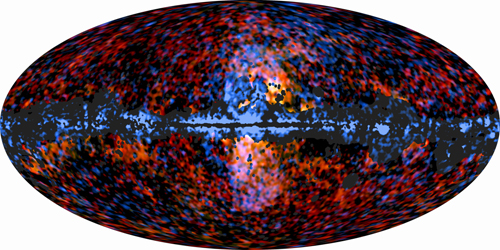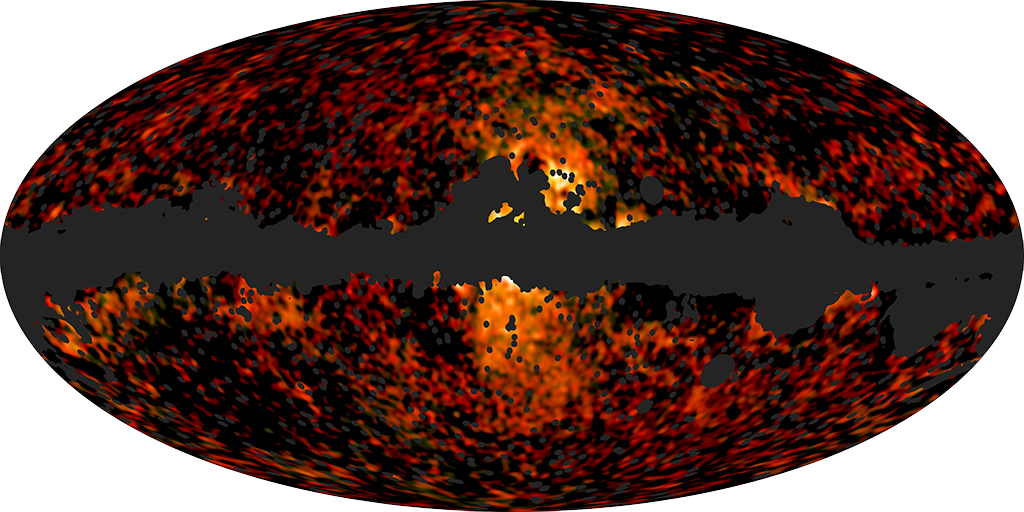| Basic Information | |
| What is this? | A haze of microwave emission originating near the centre of our Galaxy |
| Where is it in the sky? | Towards the centre of our Galaxy, in the constellations of Sagittarius, Scorpius and Ophiuchus |
| How big is it? | The haze appears to come from a region tens of thousands of light years across |
| How far away is it? | The Galactic Centre is around 30,000 light years away |
| What do the colours represent? | The red and yellow colours show the signal that remains when everything else has been accounted for. The grey band and small circles show the regions that were removed from the maps. |
Downloads
In order to extract the cosmological information from the Planck data, the emission from everything between Planck and the very distant Universe must be identified and removed. That includes emission from our Galaxy, which originates from a range of sources. At high frequencies, the Galactic emission is dominated by emission from cold dust between the stars, and Planck’s High Frequency Instrument is excellently placed to identify this. At the lower frequencies, measured by the Low Frequency Instrument, the emission is primarily from electrons in the Galaxy. The more energetic electrons, which have been accelerated by passing through supernova shockwaves, emit a type of microwave emission called “synchrotron emission” as they move through magnetic fields.
In theory, after removing the signals due to dust and electrons, along with the emission from other known sources both within our Galaxy and far beyond it, all that should remain is the Cosmic Micrwave Background. A previous mission, NASA’s WMAP satellite, provided hints that this was not the case, with its data suggesting existence of spuriously energetic electrons near the Galactic Centre. Now Planck, which is much better equipped to detect and remove the other “foreground” components, has strengthened that evidence. This excess synchrotron emission, shown in the image above originates from a region near the centre of the Galaxy, and is given the name “Galactic Haze”. To extract the information, the emission from the plane of our Galaxy is removed from the analysis, as is the emission from other galaxies, which are very bright at these wavelengths. These removed regiond are shown in dark grey in the image above.
The origin of the energetic electrons that cause the haze is unknown, though there are a number of theories. It could be that the rate of supernovae is higher than expected near the Galactic Centre, which would cause more shockwaves and therefore more acceleration of the electrons. Alternatively, there would be spuriously high “Galactic winds” from near the centre of the Galaxy, possibly caused by material close to the supermiassive black hole right in the centre.

A more intriguing possibility is that the electrons are caused by the annihilation of dark matter particles with their anti-matter counterparts. Such annihilations are predicted to result in the creation of energetic electrons, and would also be more dominant in the centre of the Galaxy where the density of dark matter is greater. However, the current observations are not enough to be able to distibuish between the various theories.
One final piece of evidence is the detection of enormous “bubbles” seen in gamma rays by NASA’s Fermi satellite. These are also seen towards the Galactic Centre, though whether the two are linked is uncertain.
This is one of a number of intermediate results released based on Planck data.
